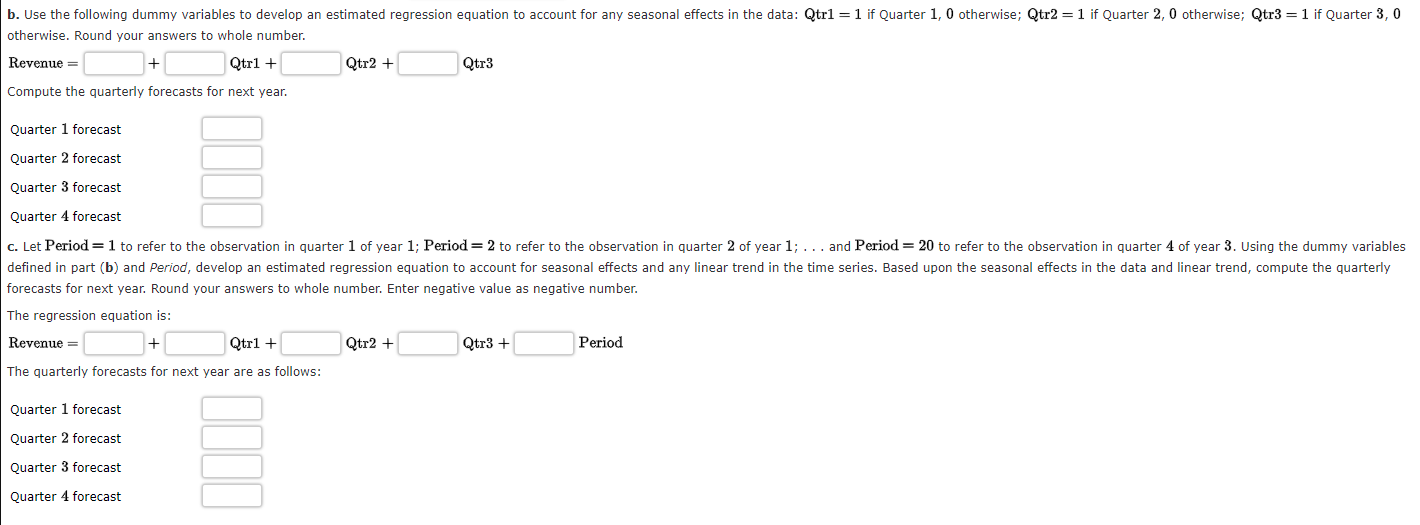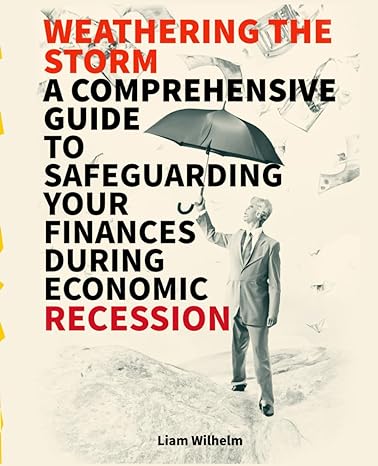

South Shore Construction builds permanent docks and seawalls along the southern shore of Long Island, New York. Although the firm has been in business only five years, revenue has increased from $305,000 in the first year of operation to $1,082,000 in the most recent year. The following data show the quarterly sales revenue in thousands of dollars. Quarter Year 1 Year 2 Year 3 Year 4 Year 5 1 18 32 74 102 182 2 102 127 153 211 282 3 170 246 325 377 443 4 15 30 40 77 175 b. Use the following dummy variables to develop an estimated regression equation to account for any seasonal effects in the data: Qtrl = 1 if Quarter 1, 0 otherwise; Qtr2 = 1 if Quarter 2, 0 otherwise; Qtr3 = 1 if Quarter 3,0 otherwise. Round your answers to whole number. Revenue = Qtrl + Qtr2 + Qtr3 Compute the quarterly forecasts for next year. Quarter 1 forecast Quarter 2 forecast Quarter 3 forecast Quarter 4 forecast c. Let Period=1 to refer to the observation in quarter 1 of year 1; Period=2 to refer to the observation in quarter 2 of year 1; ... and Period = 20 to refer to the observation in quarter 4 of year 3. Using the dummy variables defined in part (b) and Period, develop an estimated regression equation to account for seasonal effects and any linear trend in the time series. Based upon the seasonal effects in the data and linear trend, compute the quarterly forecasts for next year. Round your answers to whole number. Enter negative value as negative number. The regression equation is: Revenue = + Qtrl + Qtr2 + Qtr3 + Period The quarterly forecasts for next year are as follows: Quarter 1 forecast Quarter 2 forecast Quarter 3 forecast Quarter 4 forecast South Shore Construction builds permanent docks and seawalls along the southern shore of Long Island, New York. Although the firm has been in business only five years, revenue has increased from $305,000 in the first year of operation to $1,082,000 in the most recent year. The following data show the quarterly sales revenue in thousands of dollars. Quarter Year 1 Year 2 Year 3 Year 4 Year 5 1 18 32 74 102 182 2 102 127 153 211 282 3 170 246 325 377 443 4 15 30 40 77 175 b. Use the following dummy variables to develop an estimated regression equation to account for any seasonal effects in the data: Qtrl = 1 if Quarter 1, 0 otherwise; Qtr2 = 1 if Quarter 2, 0 otherwise; Qtr3 = 1 if Quarter 3,0 otherwise. Round your answers to whole number. Revenue = Qtrl + Qtr2 + Qtr3 Compute the quarterly forecasts for next year. Quarter 1 forecast Quarter 2 forecast Quarter 3 forecast Quarter 4 forecast c. Let Period=1 to refer to the observation in quarter 1 of year 1; Period=2 to refer to the observation in quarter 2 of year 1; ... and Period = 20 to refer to the observation in quarter 4 of year 3. Using the dummy variables defined in part (b) and Period, develop an estimated regression equation to account for seasonal effects and any linear trend in the time series. Based upon the seasonal effects in the data and linear trend, compute the quarterly forecasts for next year. Round your answers to whole number. Enter negative value as negative number. The regression equation is: Revenue = + Qtrl + Qtr2 + Qtr3 + Period The quarterly forecasts for next year are as follows: Quarter 1 forecast Quarter 2 forecast Quarter 3 forecast Quarter 4 forecast








